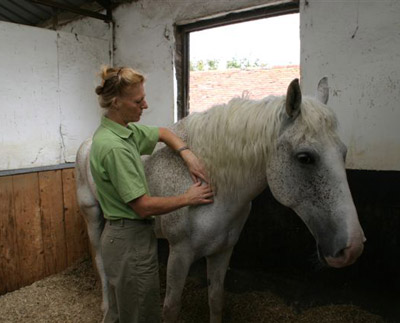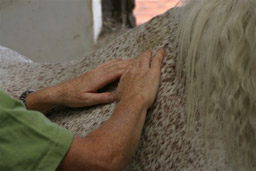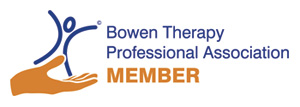EQUINE BOWEN TECHNIQUE
  I qualified as an Equine Bowen Therapist with Beth Darrell of the European School of Equine Bowen Therapy (www.equinebowentherapy.com) affiliated to ECBS (European School of Bowen Studies www.thebowentechnique.com) in 2005. It is a prerequisite of being accepted onto this course to have the required equine experience entry level. Also it is a prerequisite to qualify as a Human Bowen practitioner. This is useful when the rider and horse both need treatment as imbalances in the rider are translated to our mounts. The equine education covers not only anatomy and physiology and conformation but also a broad spectrum of topics related to horse health and fitness. Including saddles and fitting, foot balance, gait analysis, nutrition, the language of the horse. I qualified as an Equine Bowen Therapist with Beth Darrell of the European School of Equine Bowen Therapy (www.equinebowentherapy.com) affiliated to ECBS (European School of Bowen Studies www.thebowentechnique.com) in 2005. It is a prerequisite of being accepted onto this course to have the required equine experience entry level. Also it is a prerequisite to qualify as a Human Bowen practitioner. This is useful when the rider and horse both need treatment as imbalances in the rider are translated to our mounts. The equine education covers not only anatomy and physiology and conformation but also a broad spectrum of topics related to horse health and fitness. Including saddles and fitting, foot balance, gait analysis, nutrition, the language of the horse.
Equine Bowen Therapy (EBT) is a gentle, non-invasive hands on technique which supports/promotes healing, pain relief and re-balancing of the body. It is holistic in its approach and addresses the central nervous system, assisting the release of muscle spasm and stimulating the lymphatic and circulatory systems. It is subtle and relaxing for the horse.
 I use a light touch to make a series of focused, rolling-type moves over soft tissue, which helps to release deep tensions and imbalances in the connective tissues. Connective tissue is integral to the whole body, even bone and blood, and the Bowen Technique is giving feedback to the body through the connective tissue. This technique is facilitating the body to heal itself. It is common for horses to find the treatment very relaxing and enjoyable and often there are visible signs of releasing of tension like yawning and twitching lower lip, releasing wind etc. and looking sleepy and chilled. They can also be restless is there is discomfort held in some areas, but this usually subsides as the treatment progresses. I use a light touch to make a series of focused, rolling-type moves over soft tissue, which helps to release deep tensions and imbalances in the connective tissues. Connective tissue is integral to the whole body, even bone and blood, and the Bowen Technique is giving feedback to the body through the connective tissue. This technique is facilitating the body to heal itself. It is common for horses to find the treatment very relaxing and enjoyable and often there are visible signs of releasing of tension like yawning and twitching lower lip, releasing wind etc. and looking sleepy and chilled. They can also be restless is there is discomfort held in some areas, but this usually subsides as the treatment progresses.
During the treatment, there are two minute intervals, when the horse is left to rest, allowing the body to assimilate the information given in the moves, allowing fine adjustments to take place.
The treatment is commenced at least 2 hours after a hard feed to allow for digestion.
There is no adjustment of hard tissue and no force is used. A treatment takes approximately one hour and two or three treatments will often correct many imbalances, although further treatment will be required in some instances.
Conditions that respond well to EBT include unlevelness, disunited gait, muscle atrophy or asymmetrical development, stiffness, back soreness and some stress related behavioural problems.
The body is treated as a whole, without referral to named disease. Diagnosis or prescription for any condition falling under the scope of medical or veterinary practice is explicitly excluded from the remit of EBT qualified practitioners.
It has been confirmed by the RCVS that EBT is covered as a manual therapy, under the Veterinary Surgery (Exemptions) Order 1962 and therefore lay practitioners are allowed to use it, with the consent of the animal’s veterinary surgeon and I welcome referrals from all veterinary surgeons.
|
Amanda Cutler-Little, Bowen therapist in West Sussex. Bowen Technique, Bowen Therapy and Bowen describe the light touch therapy devised by Tom Bowen in Australia. Bowen Therapy is holistic, treating the whole patient, not just symptoms and has been reported to be effective for conditions such as low back pain, sciatica, headache, migraine, asthma, shoulder pain, neck problems, tennis elbow, golfer's elbow, RSI and other musculo-skeletal conditions. Bowen Therapy can often have a relaxing effect which may help people suffering from tension or stress syndromes. |
 |
Website maintained by
RB Web Design (UK). |
|


 I qualified as an Equine Bowen Therapist with Beth Darrell of the European School of Equine Bowen Therapy (
I qualified as an Equine Bowen Therapist with Beth Darrell of the European School of Equine Bowen Therapy ( I use a light touch to make a series of focused, rolling-type moves over soft tissue, which helps to release deep tensions and imbalances in the connective tissues. Connective tissue is integral to the whole body, even bone and blood, and the Bowen Technique is giving feedback to the body through the connective tissue. This technique is facilitating the body to heal itself. It is common for horses to find the treatment very relaxing and enjoyable and often there are visible signs of releasing of tension like yawning and twitching lower lip, releasing wind etc. and looking sleepy and chilled. They can also be restless is there is discomfort held in some areas, but this usually subsides as the treatment progresses.
I use a light touch to make a series of focused, rolling-type moves over soft tissue, which helps to release deep tensions and imbalances in the connective tissues. Connective tissue is integral to the whole body, even bone and blood, and the Bowen Technique is giving feedback to the body through the connective tissue. This technique is facilitating the body to heal itself. It is common for horses to find the treatment very relaxing and enjoyable and often there are visible signs of releasing of tension like yawning and twitching lower lip, releasing wind etc. and looking sleepy and chilled. They can also be restless is there is discomfort held in some areas, but this usually subsides as the treatment progresses.